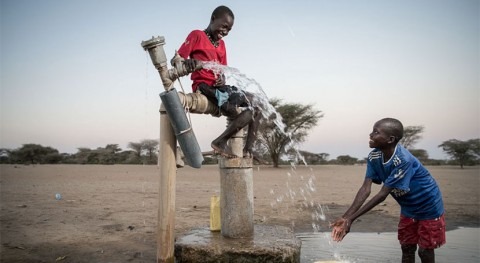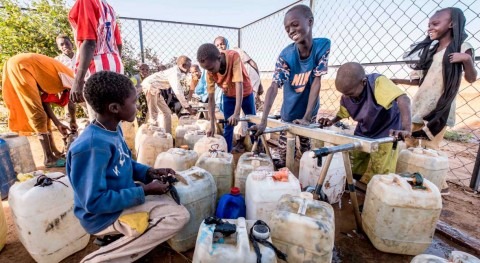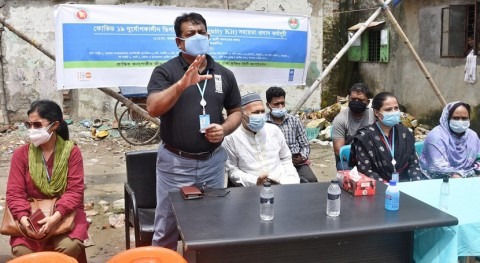The extent of coastal flooding has increased over the past 20 years as a result of sea level rise, meaning 14 million more people worldwide now live in coastal communities with a 1-in-20 annual chance of flooding, new data reveals. Continuing our current course of global greenhouse gas emissions (SSP2-4.5) is projected by the end of the century to expand this 1-in-20 floodplain to areas today populated by nearly 73 million people.
New hyperlocal data released by Human Climate Horizons, a collaboration between the United Nations Development Programme (UNDP) and the Climate Impact Lab (CIL), maps in detail this fivefold increase in susceptibility to flood damage along the world’s densely populated coastlines. The data platform makes it possible to see where sea-level rise impacts may most threaten homes and infrastructure.
Hundreds of highly populated cities will face increased flood risk by midcentury, relative to a future without climate change. This includes land home to roughly 5 percent of the population of coastal cities such as Santos, Brazil, Cotonou, Benin, and Kolkata, India. Flood risk exposure is anticipated to double to 10 percent of the population by the end of the century.
Many low-lying regions along the coasts of Latin America, Africa, and Southeast Asia may face a severe threat of permanent inundation, part of an alarming trend with the potential to trigger a reversal in human development in coastal communities worldwide. By 2100, climate change is expected to cause the submergence of a significant share of land (>5 percent) in the following Small Island Developing States (SIDS) and Associate Members of United Nations Regional Commissions: Bahamas, British Virgin Islands, Cayman Islands, Maldives, Marshall Islands, Turks and Caicos, Tuvalu, and Seychelles.
Flood risk exposure is anticipated to double to 10 percent of the population by the end of the century
At the highest levels of global warming (SSP5-8.5), approximately 160,000 square kilometers of coastal land (an area larger than the territory of Greece or Bangladesh) would be inundated by 2100, compared to a future with no climate change. This includes vast stretches of coastal cities in Ecuador, India, Saudi Arabia, Vietnam, and the United Arab Emirates—host of COP28. With concerted action to reduce global emissions and put the world on track to limit warming below 2 degrees Celsius (SSP1-2.6), 70,000 square kilometers of that at-risk land is projected to remain above sea level.
“The effects of rising sea levels will put at risk decades of human development progress in densely populated coastal zones which are home to one in seven people in the world,” said Pedro Conceição, Director of UNDP’s Human Development Report Office. “The displacement of millions of people and the disruption of economic activity in major business hubs could introduce new elements of instability and increase competition for resources. Our new research from UNDP and Climate Impact Lab is another reminder to the decision makers going to COP28 that the time to act is now.”
Without shoreline defenses, under a worst-case warming scenario by the end of the century, 5 percent or more of the following cities are projected to fall permanently below sea level:
- Guayaquil, Ecuador
- Barranquilla, Colombia
- Santos, Brazil
- Rio de Janeiro, Brazil
- Kingston, Jamaica
- Cotonou, Benin
- Kolkata, India
- Perth, Australia
- Newcastle, Australia
- Sydney, Australia
These impacts are detailed on Human Climate Horizons, empowering global citizens and decision-makers with localized information on the projected impacts of climate change over this century on people and communities. In today’s release, the platform unveils projections of local sea-level rise and its impacts on humans under three future emissions scenarios. This data is derived from satellite and tidal gauge observations and model ensembles from the Intergovernmental Panel on Climate Change (IPCC) Sixth Assessment Report. With geographic detail, the new data paints a stark picture of a world grappling with the consequences of melting ice in mountain glaciers and at the poles, and seawater expanding as it warms.
"These projections are not foregone conclusions; instead, they can be a catalyst for action," said Hannah Hess, associate director at the Climate Impact Lab. "Swift and sustained action to reduce emissions will affect how quickly and how much coastal communities are impacted. Reducing emissions not only mitigates risk but buys us more time to proactively respond and prepare for rising seas."
In addition to the latest sea-level rise impacts, the platform illustrates how climate change is projected to influence temperature and its impacts on mortality, energy use, and the global workforce. These projections are available under multiple scenarios of greenhouse gas emissions for 24,000 regions worldwide, shedding light on the implications for our collective future, revealing vast inequalities within and between countries, and pinpointing areas where the risks of unmitigated climate change are most severe.










